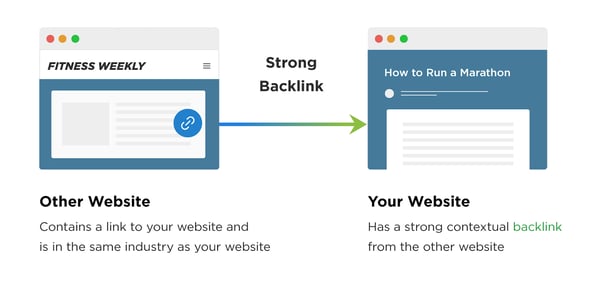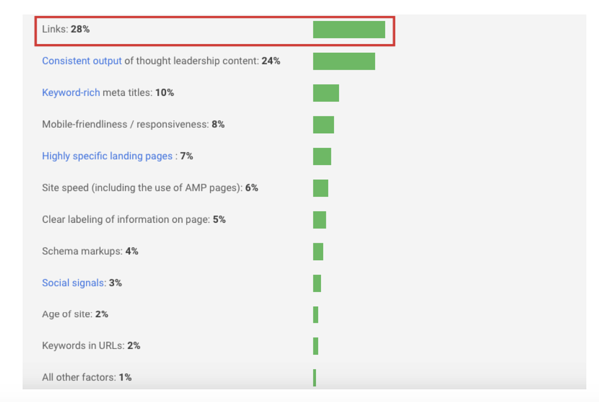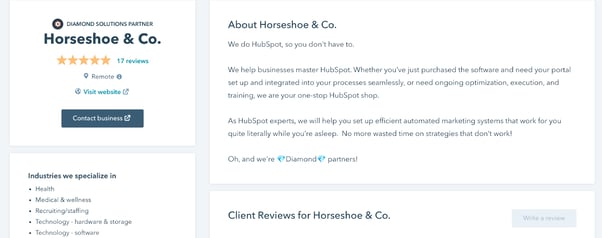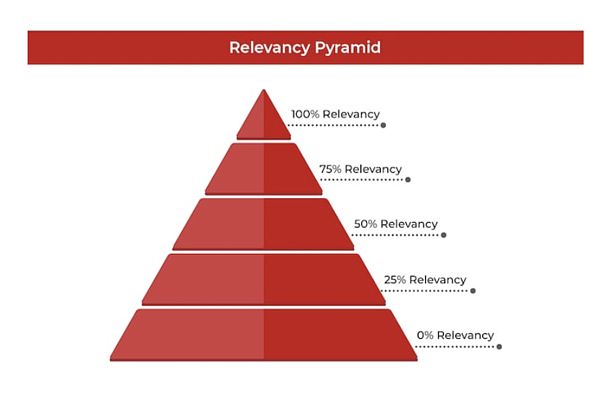Backlinks are a critical factor in determining if and how high your website ranks on Google and other search engines.
But just how do you acquire quality backlinks that will make your website rank for keywords relevant to your business?
Keep reading to discover how backlinks influence your website's search rankings and the strategies you should be using to obtain them in 2022.
Note: This blog was originally published in August 2019 and has been updated for accuracy and freshness.
What are backlinks?

Backlinks are links to your website that are published on other websites. They may be hyperlinks directly in a body of text, images, or simply plain text links. Backlinks are a key part of how Google ranks individual pages and websites in search results.
Why do backlinks matter?
Backlinks are a measure of a website's real-life authority on the subject matter it addresses and a major factor search engine algorithms consider when ranking crawled pages.
Every backlink you obtain shows Google your site contains relevant, high-quality content that other websites want to link to. If you have reputable and established websites linking to your content, Google will know it’s read-worthy and authoritative enough to show users when they’re looking for information on your topic.
Each backlink is like a vote of confidence for your site. And unlike factors like the number of keywords or the amount of time users spend on your site, backlinks cannot be easily faked or manipulated.

Types of backlinks
There are two types of backlinks: nofollow and dofollow links.
Search engines will crawl and factor dofollow links into their ranking criteria, while the nofollow tag is a request for search engines to ignore indexing a link.
Dofollow links go a long way in determining a page's search ranking, and as a result, are valued higher than nofollow links and should be the main focus of your SEO efforts.
Pro tip: Not sure how to determine if a link is dofollow or nofollow? Navigate to View > Page Source and do a search for nofollow. If it doesn’t appear around the link in question, it’s a dofollow!
Does backlinking work?
Yes, backlinking still works in 2022 and shows no signs of slowing down.
Backlinks are STILL the #1 way to determine the quality of a webpage. While the Google algorithm is always being updated to consider things like link quality over quantity, the fact remains that backlinking is incredibly important if you want to show up in search.
Design your website for backlinking success
Before executing your backlinking strategy, it's important to note some pertinent basics that will serve as the foundation of any search engine optimization campaign.
1. Prioritize high-quality content
Google's algorithm is designed to rank useful information higher in search results so users can get what they're looking for in less time. The intent is to discourage keyword-stuffed pages that don’t offer value to users.
One of the (many) ways Google determines if your content is actually relevant to readers is by tracking page bounce rates. If a high volume of users land on your ranking page, quickly realize there’s no useful information, and leave, Google will take it as a sign that your page doesn’t have relevant or helpful info. They’ll start to outrank your content with pages that do engage potential customers.
To avoid this problem, create high-quality content that is valuable to readers and will encourage them to stick around and read what you have to say.
And as long as your message is valuable, don’t be afraid to make it lengthy! Longform content gets 77.2% more links than short form content… as long as it's unique and helpful to readers.
2. Optimize for UX and conversion
Before pursuing backlinks, it’s important to optimize your site for the users who will be landing there. Consider these factors:
Page load speed
A two-second page load delay can increase your bounce rate by over 100%. Don’t let Google assume your content isn’t worth your readers’ time! Use Google’s free PageSpeed Insights tool to check your pages’ load time and access recommendations for decreasing it.

Lead forms
As a nod towards a well-grounded lead generation strategy, forms can help close as much as 21.5% of the leads landing on your ranking pages. Carefully consider the form questions you’re asking customers to enter. Typically, the more fields, the lower the conversion rate.
Call-to-Actions (CTAs)
CTAs help push your readers along the buyer’s journey and answer the question: “What next?”.
A few pointers to nail your CTAs would be to:
- Leverage urgency to prompt conversions
- Speak to your prospects’ needs personally. E.g. become a better you, sleep better, etc.
- Promise an exciting result
- Offer a free incentive
Great calls-to-action remind readers ‘why’ they ever began reading in the first place, making it easier to convert them. And in the end, conversions are the primary reason for building backlinks.
Internal links
Have a page that already has plenty of strong backlinks? Transfer that authority to new SEO pages! By adding relevant, helpful links within your own popular website pages, you’ll encourage users to keep clicking, spend more time on your site, and discover new content with you.
Site and page structure
Google crawls each page of your website to get the full picture of your content. If you have random pages that aren’t part of your site map, an overly complex navigation scheme, or poorly formatted pages, Google won’t be able to properly index your site.
Before focusing on SEO, take a few moments to ensure your website is clear, logical, and easy to follow for computers and readers alike.
Keywords
Not as important as backlinks perhaps, but keywords are still essential in telling Google (and readers) what your website is about. Make sure the topics you want to rank for appear prominently in your content, especially in H1 and H2 tags.
Do remember that Google penalizes ‘keyword stuffing’: don’t use your keywords in every sentence. They should only appear when it’s logical to do so.
3. Be patient
SEO specialists agree that on the average, it may take as much as 3-6 months to rank for high value keywords, even with a well-rounded SEO strategy.
Your competitors are also likely driving an SEO strategy, which means you’ll be contending for the top positions.
4. Call in an expert
Need to increase your backlinks, but don’t have the time or knowledge to make website changes? We’ve got you covered!
Our team of design and development experts have designed dozens of HubSpot websites, each as unique as the business they represent. Get in touch today.
Methods to Get High-Quality Backlinks
1. Invest in high-value, link-worthy content
In the end, the idea behind backlinking on the internet boils down to one thing: making relevant information easy to find.
Established websites with a solid profile won't give a moment's thought to linking to your website if there's no link-worthy content.
And with over 1.9 billion websites on the internet, you're up against serious competition.
Not sure what would be link-worthy in your industry? Consider the following:
- Visuals. Graphs and infographics are often widely shared, giving a wealth of opportunities to lead back to your website.
- List posts. Whether it’s 10 helpful tricks or a list of recipes, lists are among the most commonly linked posts on the internet
- Original research. Do you have a burning question that others in your industry are also wondering about? Conduct a study, publish your data, and watch the links roll in.
- In-depth guides. Since long-form content is a top-performer, why not create the ultimate guide on your industry, pulling from a wealth of other sources?
2. Brand your content
Does the valuable content you created in method #1 make a unique suggestion? If you’re coming up with a new way to help readers accomplish something, why not give it a name?
For example, a writer at Backlinko came up with a new linking strategy that he called ‘The Moving Man’ and included it in a blog post. Before long, people were referencing this strategy and even writing entire blog posts about it, each time with a link to the original blog that coined the phrase.
Come up with something fresh and new, give it a catchy name, and work hard to spread your idea as far as possible.
3. Focus on high domain authority sites
One key factor to consider before and during any backlinking campaign is the domain authority of the sites you’re getting backlinks from.
Domain authority is the measure of the real-life authority a website has acquired. It’s a scale of the importance and reliability of a website. It’s also one of the major signals search engines measure to rank pages.
For example, a backlink from a site like the New York Times or a site ending in .edu or .gov will be far more valuable to your site than a link from a random website no one has heard of.
Before pursuing acquiring links from a website, take some time to analyze their domain authority using an SEO tool (like Moz, Ahrefs, or SEMrush) to determine if it’s worth the effort.
Anything in the 40-60 (medium) to 70-99 (high) DA range is okay, but note that it takes more effort to get higher quality links.
4. Find niche and relevant directories
Google doesn’t score backlinks from directories the same way it scores backlinks from other websites, since it can be easy to get listed on a number of industry lists. The general rule is that the easier it is to acquire a backlink, the less it's worth.
However, any listing that encourages readers to visit you can help your rankings a little bit. And if you can find smaller, niche-relevant directories, they can serve as more of an authority signal that gives your website an edge over the competition.
For the perfect example, here’s what our listing on the HubSpot Agency Directory looks like:

Apart from the stellar qualifications, HubSpot linking to us signals to Google the quality of content we have to offer readers like you.
A few of the types of the directories to explore for your business include:
- Local business directories like Manta, Yelp, and Hotfrog
- Service provider directories that list partners, freelancers and agencies in a particular service niche. Some examples include HubSpot’s agency directory for marketing consultants and agencies and the Facebook Agencies directory.
Pro Tip: Here are a few search strings you can use to zero in on relevant directories:
- (Niche) + directories (e.g. Marketing agency directory, SaaS directory, Startup directory)
- (Niche) + listings (e.g. Startup listings, Marketing agency listings)
5. Leave relevant blog comments
Not all blog comments are created equal. A comment on a hairstyle blog linking to your café website could pass along the wrong signal to Google.
But if you regularly comment on high-value websites in your niche, that will send the signal that you're genuinely engaging in helpful conversations that point towards your website, boosting your site's authority in the long run.
6. Use personalized outreach
In the end, backlinks don’t build themselves; they’re inserted by actual humans. And to acquire better backlinks, you have to engage with the people who do.
To unlock more backlink opportunities, it’s essential that you begin building long term win-win relationships with webmasters, site owners, and relevant staff of the websites you’ve identified as high-value in your niche.
Instead of just sending out cold emails with a request to be linked to, it’s more reasonable to invest in quality content and then leverage your connections to get your resources linked to.
This particular technique only works if you’ve been keeping in touch with your target contacts, which could range from emails appreciating their work, a heads-up on a resource you genuinely think would be useful to them, or simply sharing and commenting on their content.
In the long run, building long-term relationships with staff on authority site teams opens up more opportunities to acquire more organic backlinks with less effort.
If you’re just starting out and haven’t built any relationships yet, that’s ok! Find ‘likely linkers’ in your niche by looking at the backlinks to a popular piece of content around your topic. Find a contact and email them a personalized script about how your content might fit their site and ask them to include a link.
7. Engage on relevant forums
Internet forums are great avenues to acquire fresh industry knowledge while gaining a few backlinks.
How?
Internet forums are designed to help members rub minds together. As such, it’s okay to link to your site — as long as you’re sharing helpful information. As you engage on forums, follow these best practices:
- Be helpful
- Keep your profile updated with relevant info and qualifications that confirm your subject-matter authority
- Share only high-value answers with the link to your site. This helps build relevance and conveys your subject matter authority to readers
In the end, the links you share on industry-specific forums will generate a decent amount of traffic, plus your website will gradually record an increase in search authority from the backlinks you’ve published.
Pro-Tip: Having trouble finding likeminded people? Try using Help a Reporter Out, a free service that connects reporters and journalists looking for information and bloggers looking to share their information and gain links.
8. Leverage the skyscraper technique
The Skyscraper technique for acquiring backlinks involves content marketing, leveraging your existing audience, and reaching out to prospects for linking opportunities.
Content research: The skyscraper technique revolves around creating content that outperforms what your competitors already have out there and leveraging it to acquire backlinks and outrank them.
To do this, you have to thoroughly analyze the search results for your target keywords and figure out what the ranking pages are offering to their readers. BuzzSumo, social media, and Google Keyword Planner are ideal tools to help discover trending content ideas with potential to attract backlinks.
Build a distribution pipeline: When your content is relevant to your buyer persona, brands or businesses in the same niche will be open to promoting your content — IF they consider it valuable. A Google search can help pinpoint these brands to take note for further outreach. If you can, target the websites linking to the content you’re trying to outrank, as they may be willing to replace their current content with an improved version.
Create better content: With all the knowledge you gleaned from existing ranking content, write the best piece on the subject matter available, creating a resource that offers more value than whatever you’re trying to outrank.
Leverage your network: Once your article is ready, promote it to your social media channels, your email list, and any content distribution networks. That way, you can create initial momentum for your content.
Direct outreach: Reach out to the relevant brands and sites you identified during step two and promote your content as a better link alternative. Again, this is where warm personal relationships with contacts come in handy.
Rinse and repeat: With the traffic you’ve generated from your email list, social channels, and outreach promotions, Google’s crawlers will pick up the signals and gradually begin offering you better rankings.
9. Try the Skyscraper technique 2.0
Coined by Backlinko, Skyscraper 2.0 is an improvement to the Skyscraper technique, with an emphasis on user intent.
Google wants searchers to find results that solve their problems and answer their questions. To achieve this, articles that appear to address user's intent get ranked higher and as a result, get more backlinks.
For example, the underlying intent of someone searching “iPhone 13 vs. Samsung Galaxy s21” is likely that they’re looking to purchase a new smartphone.
So the focus of your content should be on helping the user choose the right smartphone.
The Skyscraper 2.0 technique can help get your website ranking higher and increases the chances of your resources being linked to by simply creating better content that offers an improved user experience.
A few areas that Skyscraper 2.0 focuses on includes:
- A table of contents to make your content easier to read
- Brief, straightforward introduction that entices readers
- Title keyword optimization
It’s also necessary to point out that the Skyscraper 2.0 technique won’t explicitly drive backlinks, but rather helps you create more helpful, relevant content that is more likely to receive links.
10. Find broken links
This method is a great way to build relationships, add value, and get new backlinks all at the same time.
Find a relevant blog or resource with lots of outbound links and use the ‘Check my links’ Chrome extension to find any that are broken. Then, reach out to the person who owns the website and say you found some broken links. Make suggestions for relevant pieces of your content to replace them.
11. Locate outdated linking
Similar to broken linking, this strategy takes advantage of businesses in your industry that recently changed their name, the products or services they offer, or went out of business completely.
Let’s say someone in your niche was forced to close their doors and you know they picked up a lot of backlinks while they were still operating. You can perform a simple backlink search to find websites that are still pointing to the now-removed website. Then, reach out (again adding value to the site owner!), point out the outdated link, and suggest one of your content pieces as a potential replacement.
12. Leverage mentions
Sometimes a blog or website might mention your company or a post you’ve written, without actually linking to that post. This is a great opportunity to get links, as the writer already knows and likes you enough to mention you by name.
You can use SEO tools to identify brand mentions that don’t appear to be links. Then, send a friendly message thanking the writer for mentioning you and asking if they could add a link.
Bonus: if the conversation goes well, you might be able to suggest new content and get additional links!
Blackhat Backlinking: 3 Methods to Avoid
Blackhat backlinking strategies have been floating around for years with the intent to acquire undeserved search rankings. But with each update to Google's algorithm, it's actually harder and riskier for a business to survive on blackhat backlinking strategies since a single algorithm update could ruin your site.
Here are three blackhat backlinking tactics you should steer clear of if you want to avoid trouble with Google.
1. Paid backlinking
It happens: businesses actually buy links from link vendors. But not only is it unhealthy for a long-term backlinking strategy, Google frowns on paid link scheming.
Google policies make it clear that not only will you get penalized for acquiring paid links, but that the insights derived from your case will be factored into further algorithmic updates to ensure any similar paid scheme you embark on gets flagged and penalized.
Penalties for paid backlinking could range from decreased visibility in search results to having your entire site de-indexed.
2. Blog comment spamming
Randomly adding links to your site in the comments section of unrelated authority sites may seem like a fabulous idea to get a high volume of links… except it’s not.
Blog comment spamming will almost certainly get your links discounted, sending negative signals that will eventually hurt your website’s profile.
3. Backlinks from irrelevant sites
Another fundamental authority signal Google's algorithm tracks is the relevance of the websites linking to yours.
Let’s say a golf website gets a backlink from the Royal Canadian Golf Association. Google's algorithm takes note of both the authority of the RCGA website and the relevance of it to the golf website. As a result, the receiving website gets a considerable rankings boost.
On the other hand, if the website got a backlink from a cookware site, that link will have little impact on search rankings because of the topic's irrelevance.
According to Google Webmaster guidelines, unrelated backlinks could signal a link scheme and will eventually attract manual penalties from Google.
Not all links are good links. Like the image below shows, the more niche-relevant a website linking to yours is, the higher the authority it signals.

Are you ready to build some backlinks?
In the end, it's obvious that generating quality backlinks from authority sites is incredibly important if you want to show up in Google and get discovered by new potential customers. However, it’s also a time-consuming, manual, and sometimes difficult process that can take years to pay off.
Do you need help creating a beautiful website that domains can’t wait to link to? Or maybe a content strategy that will really get that rankings boost? Reach out to Horseshoe & Co. and let’s get started.



